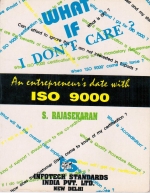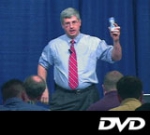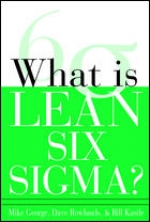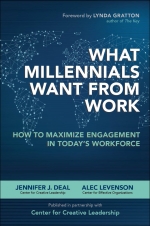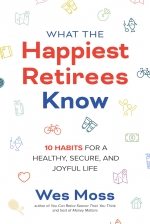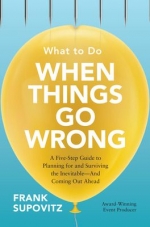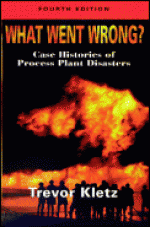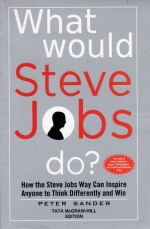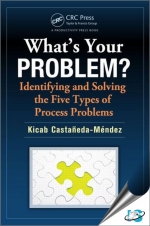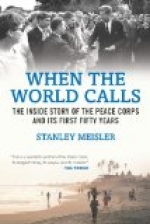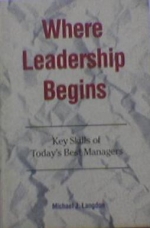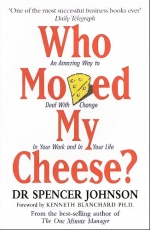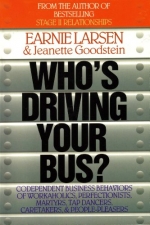Site Breadcrumb
Total Record : 10230
ISBN: 8174890017 / 9788174890016
Year: 1994
Availability: Out of Stock print- - printmohan 55555- n 555555
print- - print...
| Buy This Item |
| List Price: ` 280 |

Notify Me |
ISBN: 0872637271 / 9780872637276
Year: 2004
Availability: 45-60 days print-
Many manufacturers put great effort into their lean initiatives, but never realize the vision of performance excellence. This video shows how the secret to success in lean production is the ability to get large numbers of employee ideas. Both office and production workers see many problems and opportunities their managers miss. They have lots of ideas to save money and improve efficiency. The leanest companies in the world routinely implement more than twenty ideas per employee per year. The video concludes with an overview of the concepts in the rest of the series.
- printmohan 55555- n 555555print-
Many manufacturers put great effort into their lean initiatives, but never realize the vision of performance excellence. This video shows how the secret to success in lean production is the ability to get large numbers of employee ideas. Both office and production workers see many problems and opportunities their managers miss. They have lots of ideas to save money and improve efficiency. The leanest companies in the world routinely implement more than twenty ideas per employee per year. The video concludes with an overview of the concepts in the rest of the series.
- print...ISBN: 0071802258 / 9780071802253
Year: 2013
Availability: Out of Stock print-
PRACTICAL COVERAGE OF BUSINESS PROCESS MANAGEMENT FUNDAMENTALS
This concise, easy-to-understand guide provides a straightforward introduction to the tools and techniques required to implement business process management (BPM), and how it can benefit any organization. Written by an instructor at the BPM Institute, What Is BPM? explains the management strategies, integrated methodologies, and software solutions essential to a successful enterprise-wide BPM implementation. Discover how to roll out a systematic approach to continuous process improvement in your organization and deliver sustained operational performance.
Find out how to:
- Identify value chain processes within your organization
- Understand the document, assess, improve, and manage phases of BPM
- Select process improvement tools, such as process mapping, Six Sigma, and Lean
- Transform to a process-managed enterprise
- Evaluate BPM software and platforms
print-
PRACTICAL COVERAGE OF BUSINESS PROCESS MANAGEMENT FUNDAMENTALS
This concise, easy-to-understand guide provides a straightforward introduction to the tools and techniques required to implement business process management (BPM), and how it can benefit any organization. Written by an instructor at the BPM Institute, What Is BPM? explains the management strategies, integrated methodologies, and software solutions essential to a successful enterprise-wide BPM implementation. Discover how to roll out a systematic approach to continuous process improvement in your organization and deliver sustained operational performance.
Find out how to:
- Identify value chain processes within your organization
- Understand the document, assess, improve, and manage phases of BPM
- Select process improvement tools, such as process mapping, Six Sigma, and Lean
- Transform to a process-managed enterprise
- Evaluate BPM software and platforms
| Buy This Item |
| List Price: $ 16 |

Notify Me |
ISBN: 007060505X / 9780070605053
Year: 2005
Availability: In Stock print-
A powerful program for building new levels of Six Sigma excellence into every process, product, or service
Design for Six Sigma (DFSS) allows managers to customize and improve upon Six Sigma, the most renowned, effective business improvement system of the past decade. What is Design for Six Sigma?, the step-by-step user's guide to DFSS, details everything you need to know to seamlessly introduce DFSS to your firm's quality initiative, including:
- The primary elements of a DFSS project, with specific actions managers must take to implement each effectively
- The timeline of DFSS, from identifying and clarifying what will be worked on to testing and deploying the new process, product or service
- Questions you should ask yourself before making the move to DFSS
- Primary tools and approaches used on virtually every DFSS project, from Kano Analysis to Quality Function Deployment (QFD), Capability Analysis, and more
- Practical tips for managers championing a DFSS effort as well as teams executing the project
A wide range of industries and companies now rely on Six Sigma methods and principles to boost productivity, realize dramatic cost savings, and create true customer delight. What is Design for Six Sigma? reveals how and why DFSS can help you move beyond Six Sigma, transforming change from a nuisance into a core competency and increasing your assurance that each product, service, or process your firm introduces is customer focused, defect free, and financially successful.
- printmohan 55555- n 555555print-
A powerful program for building new levels of Six Sigma excellence into every process, product, or service
Design for Six Sigma (DFSS) allows managers to customize and improve upon Six Sigma, the most renowned, effective business improvement system of the past decade. What is Design for Six Sigma?, the step-by-step user's guide to DFSS, details everything you need to know to seamlessly introduce DFSS to your firm's quality initiative, including:
- The primary elements of a DFSS project, with specific actions managers must take to implement each effectively
- The timeline of DFSS, from identifying and clarifying what will be worked on to testing and deploying the new process, product or service
- Questions you should ask yourself before making the move to DFSS
- Primary tools and approaches used on virtually every DFSS project, from Kano Analysis to Quality Function Deployment (QFD), Capability Analysis, and more
- Practical tips for managers championing a DFSS effort as well as teams executing the project
A wide range of industries and companies now rely on Six Sigma methods and principles to boost productivity, realize dramatic cost savings, and create true customer delight. What is Design for Six Sigma? reveals how and why DFSS can help you move beyond Six Sigma, transforming change from a nuisance into a core competency and increasing your assurance that each product, service, or process your firm introduces is customer focused, defect free, and financially successful.
- print...ISBN: 0070586675 / 9780070586673
Year: 2007
Availability: Out of Stock print-
Lean Six Sigma combines the two most important improvement trends of our time: making work better (using Six Sigma) and making work faster (using Lean principles). In this plain-English guide, you?ll discover how this remarkable quality improvement method can give you the tools to identify and eliminate waste and quality problems in your own work area.
Packed with diagrams, cartoons, and real-life examples, What is Lean Six Sigma? reveals the ?four keys? of Lean Six
Sigma and how they apply to your own job:
- Delight your customers with speed and quality
- Improve your processes
- Work together for maximum gain
- Base decisions on data and facts
You'll see the big picture of what your company hopes to gain with Lean Six Sigma, how it may affect your work area, and what it can mean to you personally.
- printmohan 55555- n 555555print-
Lean Six Sigma combines the two most important improvement trends of our time: making work better (using Six Sigma) and making work faster (using Lean principles). In this plain-English guide, you?ll discover how this remarkable quality improvement method can give you the tools to identify and eliminate waste and quality problems in your own work area.
Packed with diagrams, cartoons, and real-life examples, What is Lean Six Sigma? reveals the ?four keys? of Lean Six
Sigma and how they apply to your own job:
- Delight your customers with speed and quality
- Improve your processes
- Work together for maximum gain
- Base decisions on data and facts
You'll see the big picture of what your company hopes to gain with Lean Six Sigma, how it may affect your work area, and what it can mean to you personally.
- print...| Buy This Item |
| List Price: ` 325 |

Notify Me |
ISBN: 0139524339 / 9780139524332
Year: 1985
Availability: Out of Stock print- - printmohan 55555- n 555555
print- - print...
| Buy This Item |
| List Price: $ 39.95 |
| Discount: 10% |
| Offer Price: $ 35.96 |

Notify Me |
ISBN: DV07PUB12
Year: 2007
Availability: 45-60 days print-
On every lean journey, what may seem easy to understand isn't always easy to implement. Part of SME's award-winning Manufacturing Insights Video Series (MI) and produced in cooperation with the Association for Manufacturing Excellence (AME), this video shows you what lean means today by exploring its visible evidence and promise. This program is an updated version of AME's classic 1992 video release.
George Koenigsaecker, president of Lean Investments, LLC and Lean Sensei for nearly three decades, provides an updated analysis of the lean concepts as they relate to the operations of a leading Shingo-Prize-winning company Hearth & Home Technologies in Mount Pleasant, Iowa. You'll see the current state of this lean company and witness the employee culture required to fuel its journey.
See it first-hand, then apply it to your operations!
Learn why the management behavior at Toyota is often different than in most organizations.
See how to combat first-time uneasiness of lean behavior by placing it in context with continuous improvement.
print-
On every lean journey, what may seem easy to understand isn't always easy to implement. Part of SME's award-winning Manufacturing Insights Video Series (MI) and produced in cooperation with the Association for Manufacturing Excellence (AME), this video shows you what lean means today by exploring its visible evidence and promise. This program is an updated version of AME's classic 1992 video release.
George Koenigsaecker, president of Lean Investments, LLC and Lean Sensei for nearly three decades, provides an updated analysis of the lean concepts as they relate to the operations of a leading Shingo-Prize-winning company Hearth & Home Technologies in Mount Pleasant, Iowa. You'll see the current state of this lean company and witness the employee culture required to fuel its journey.
See it first-hand, then apply it to your operations!
Learn why the management behavior at Toyota is often different than in most organizations.
See how to combat first-time uneasiness of lean behavior by placing it in context with continuous improvement.
ISBN: 1259029034 / 9781259029035
Year: 2012
Availability: Out of Stock print-
Master the skills that icons throughout history have used to achieve the highest levels of success
'This is an intelligent, knowledgeable presentation of management. The pragmatic approach of learning from icons makes the book extremely worthwhile reading for up-and-coming and experienced managers alike.'
'Dr. Helmut O. Maucher, Honorary Chairman of the Board, Nestle
'Embracing a broad variety of successful personalities from all walks of life, this analysis of management skills makes for interesting reading and provides a great source of inspiration."
'Dr. Josef Ackermann, Chairman of the Management Board and the Group Executive Committee, Deutsche Bank AG
'Arnold cleverly explains the keys to successful management with references to real-life challenges successfully overcome by iconic leaders. This entertaining book is insightful, thought-provoking, and of immense practical value.'
'Fred B. Irwin, President, American Chamber of Commerce in Germany
'Profound management know-how and coverage of a wide range of valuable issues provide great inspiration for anyone seeking to apply effective management principles in practice.'
'Professor Klaus Evard, founder and former President of the European Business School
'Management know-how translates into knowledge of how to succeed in all levels of life, and everyone can learn to be successful. That is the simple premise behind this book.'
'Frankfurter Allgemeine Zeitung
What do Barack Obama, Steve Jobs, Pablo Picasso, and Napoleon have in common'
EXCELLENT MANAGEMENT SKILLS
It doesn't matter what your field of expertise is, whom you know, or how educated you are. If you have powerful management skills, you will succeed; if you don't, you'll hit the ceiling sooner rather than later.
In What Makes Great Leaders Great, bestselling author and leadership expert Frank Arnold gathers 56 icons from various fields'from business and sports to politics and pop culture'to reveal the specific management skills they used to reach the top.
For every line of work or personal goal, effectively applying these management skills will lead to ultimate success. All the people in this remarkably diverse group figured out what they needed to know to manage their rise to the top'and executed it with superb skill. What Makes Great Leaders Great includes:
- Bill Gates on harnessing the power of a business mission
- Nicolaus Copernicus on questioning every assumption
- Phil Knight on fine-tuning the right strategy
- Michael Dell on making the customer your number-one priority
- Michelangelo on focusing on a single objective
- Joseph Schumpeter on practicing creative destruction
- Roger Federer on self-motivation
- Hippocrates on behaving responsibly
- Steve Jobs on implementing ideas
- Ray Kroc on envisioning the future
- Gen. George Patton on clearly defining assignments
- Warren Buffett on demanding effective management
- Stephen Hawking on making the best use of your time
- Pablo Picasso on fostering life-long creativity
- Muhammad Yunus on looking beyond your own interests
Learn from the best in the business'and history'how to leverage your skills, knowledge, and talent to reach levels of success you never dreamed possible.
print-
Master the skills that icons throughout history have used to achieve the highest levels of success
'This is an intelligent, knowledgeable presentation of management. The pragmatic approach of learning from icons makes the book extremely worthwhile reading for up-and-coming and experienced managers alike.'
'Dr. Helmut O. Maucher, Honorary Chairman of the Board, Nestle
'Embracing a broad variety of successful personalities from all walks of life, this analysis of management skills makes for interesting reading and provides a great source of inspiration."
'Dr. Josef Ackermann, Chairman of the Management Board and the Group Executive Committee, Deutsche Bank AG
'Arnold cleverly explains the keys to successful management with references to real-life challenges successfully overcome by iconic leaders. This entertaining book is insightful, thought-provoking, and of immense practical value.'
'Fred B. Irwin, President, American Chamber of Commerce in Germany
'Profound management know-how and coverage of a wide range of valuable issues provide great inspiration for anyone seeking to apply effective management principles in practice.'
'Professor Klaus Evard, founder and former President of the European Business School
'Management know-how translates into knowledge of how to succeed in all levels of life, and everyone can learn to be successful. That is the simple premise behind this book.'
'Frankfurter Allgemeine Zeitung
What do Barack Obama, Steve Jobs, Pablo Picasso, and Napoleon have in common'
EXCELLENT MANAGEMENT SKILLS
It doesn't matter what your field of expertise is, whom you know, or how educated you are. If you have powerful management skills, you will succeed; if you don't, you'll hit the ceiling sooner rather than later.
In What Makes Great Leaders Great, bestselling author and leadership expert Frank Arnold gathers 56 icons from various fields'from business and sports to politics and pop culture'to reveal the specific management skills they used to reach the top.
For every line of work or personal goal, effectively applying these management skills will lead to ultimate success. All the people in this remarkably diverse group figured out what they needed to know to manage their rise to the top'and executed it with superb skill. What Makes Great Leaders Great includes:
- Bill Gates on harnessing the power of a business mission
- Nicolaus Copernicus on questioning every assumption
- Phil Knight on fine-tuning the right strategy
- Michael Dell on making the customer your number-one priority
- Michelangelo on focusing on a single objective
- Joseph Schumpeter on practicing creative destruction
- Roger Federer on self-motivation
- Hippocrates on behaving responsibly
- Steve Jobs on implementing ideas
- Ray Kroc on envisioning the future
- Gen. George Patton on clearly defining assignments
- Warren Buffett on demanding effective management
- Stephen Hawking on making the best use of your time
- Pablo Picasso on fostering life-long creativity
- Muhammad Yunus on looking beyond your own interests
Learn from the best in the business'and history'how to leverage your skills, knowledge, and talent to reach levels of success you never dreamed possible.
| Buy This Item |
| List Price: ` 638 |

Notify Me |
ISBN: 0071842675 / 9780071842679
Year: 2015
Availability: Send us an Email (info@standardsmedia.com) for more details print-
The most comprehensive, in-depth look at Millennials to date—essential for managers, HR professionals, and global business leaders seeking to align long-term organizational goals with the realities of the new workforce
Millennials have been burdened with a reputation as spoiled, lazy, and entitled, but the reality behind the stereotype is far richer and more complex. Who are Millennials and what do they really want?
Based on fieldwork and survey data from global research on more than 25,000 Millennials and 29,000 older workers in 22 countries, this book paints a comprehensive, scientifically accurate picture of what really motivates Millennials around the world. Learn how to get the most from Millennials by:
• Improving workplace flexibility—because Millennials don’t separate life and work
• Providing adequate support and feedback—because Millennials like to learn and grow
• Coaching, not micromanaging—because Millennials value autonomy
• Designing competitive salary structures—because Millennials know what’s up
• Providing opportunities to contribute to society—because Millennials care about doing good
Millennials want a satisfying job that pays well, coworkers they like and trust, advancement opportunities, and the occasional pat on the back. Who doesn’t want those things?
This essential book explains who Millennials really are, and offers practical advice to help those who manage, lead, and work with Millennials to improve teamwork, increase productivity, strengthen organizational culture, and build a robust talent pipeline.
Jennifer J. Deal is a senior research scientist at the Center for Creative Leadership and an affiliated research scientist at the Center for Effective Organizations at the University of Southern California.
Alec Levenson is a senior research scientist at the Center for Effective Organizations at the Marshall School of Business at the University of Southern California.
print-
The most comprehensive, in-depth look at Millennials to date—essential for managers, HR professionals, and global business leaders seeking to align long-term organizational goals with the realities of the new workforce
Millennials have been burdened with a reputation as spoiled, lazy, and entitled, but the reality behind the stereotype is far richer and more complex. Who are Millennials and what do they really want?
Based on fieldwork and survey data from global research on more than 25,000 Millennials and 29,000 older workers in 22 countries, this book paints a comprehensive, scientifically accurate picture of what really motivates Millennials around the world. Learn how to get the most from Millennials by:
• Improving workplace flexibility—because Millennials don’t separate life and work
• Providing adequate support and feedback—because Millennials like to learn and grow
• Coaching, not micromanaging—because Millennials value autonomy
• Designing competitive salary structures—because Millennials know what’s up
• Providing opportunities to contribute to society—because Millennials care about doing good
Millennials want a satisfying job that pays well, coworkers they like and trust, advancement opportunities, and the occasional pat on the back. Who doesn’t want those things?
This essential book explains who Millennials really are, and offers practical advice to help those who manage, lead, and work with Millennials to improve teamwork, increase productivity, strengthen organizational culture, and build a robust talent pipeline.
Jennifer J. Deal is a senior research scientist at the Center for Creative Leadership and an affiliated research scientist at the Center for Effective Organizations at the University of Southern California.
Alec Levenson is a senior research scientist at the Center for Effective Organizations at the Marshall School of Business at the University of Southern California.
ISBN: 9350293617 / 9789350293614
Year: 2012
Availability: In Stock print-
There are many books on leadership. What the CEO Really wants from You is one of the few to address the question that is uppermost in the mind of any manager: What he should be doing to make his or her boss his partner rather than his opponent. We spend most of our lives at work or thinking about it. Starting from a young age, fired by boundless energy and optimism, we launch into our careers sure of our abilities. Yet, things do not always turn out as we expect they would. It is not our abilities alone. The business environment is one of change and ambiguity. It is no easy task for any manager to negotiate the journey to success. As Paul Pullman, CEO of Unilever, points out in his foreword, partnerships with others, but above all with your direct boss and organization, are more important than ever before. Not only that, a good boss has an instinct for the right people, and getting them to do better. A good manager, by eliciting his help, helps himself. Few people are better qualified to guide on this journey than R. Gopalakrishnan. He brings forty-five years of experience to this subject in some of the most challenging jobs. In this immensely practical book informed by the wisdom he has gleaned over the years, he offers the reader the benefit of all he has learnt, summarized in the four As – Accomplishment, Affability, Advocacy and Authenticity.
- printmohan 55555- n 555555print-
There are many books on leadership. What the CEO Really wants from You is one of the few to address the question that is uppermost in the mind of any manager: What he should be doing to make his or her boss his partner rather than his opponent. We spend most of our lives at work or thinking about it. Starting from a young age, fired by boundless energy and optimism, we launch into our careers sure of our abilities. Yet, things do not always turn out as we expect they would. It is not our abilities alone. The business environment is one of change and ambiguity. It is no easy task for any manager to negotiate the journey to success. As Paul Pullman, CEO of Unilever, points out in his foreword, partnerships with others, but above all with your direct boss and organization, are more important than ever before. Not only that, a good boss has an instinct for the right people, and getting them to do better. A good manager, by eliciting his help, helps himself. Few people are better qualified to guide on this journey than R. Gopalakrishnan. He brings forty-five years of experience to this subject in some of the most challenging jobs. In this immensely practical book informed by the wisdom he has gleaned over the years, he offers the reader the benefit of all he has learnt, summarized in the four As – Accomplishment, Affability, Advocacy and Authenticity.
- print...ISBN: 1264269269 / 9781264269266
Year: 2021
Availability: Send us an Email (info@standardsmedia.com) for more details print-
The bestselling author of You Can Retire Sooner Than You Think and host of Money Matters reveals the 10 essential habits for a rich, rewarding, and blissful retirement.
What does it take to have a truly happy retirement? Is it money? A mortgage-free home? An active social life? A long-lasting marriage—or maybe a new one? Finance expert, author, and radio host Wes Moss asked more than 2,000 of the nation’s happiest retirees to find out—and their answers may surprise you. Through a series of revealing surveys, Moss noticed a pattern of distinct, recognizable habits that the happiest retirees shared, from the simplest of lifestyle choices to the smartest of financial strategies. These are the kinds of habits anyone can develop—the perfect road map to a healthy, secure, and joyful retirement—sooner.
Whether you’re already retired or just starting to make plans, these 10 simple actions and attitudes can make a profound difference in every aspect of your life. The book is packed with hard-won wisdom and invaluable advice on how to make little changes now that will have the biggest impact later. It’s filled with proven ways to develop smarter habits with: Money (“Think river, not reservoir”); Family (“Get your kids off your payroll”); Housing (“Live mortgage-free”); Investing (“Be a tomorrow investor”); Spending (“Be pound wise—so you can be penny foolish”); and much more. With these 10 transformational habits, you can stop obsessing over money, stay socially connected, and start enjoying your new life—as the happiest retiree on the block.
print-
The bestselling author of You Can Retire Sooner Than You Think and host of Money Matters reveals the 10 essential habits for a rich, rewarding, and blissful retirement.
What does it take to have a truly happy retirement? Is it money? A mortgage-free home? An active social life? A long-lasting marriage—or maybe a new one? Finance expert, author, and radio host Wes Moss asked more than 2,000 of the nation’s happiest retirees to find out—and their answers may surprise you. Through a series of revealing surveys, Moss noticed a pattern of distinct, recognizable habits that the happiest retirees shared, from the simplest of lifestyle choices to the smartest of financial strategies. These are the kinds of habits anyone can develop—the perfect road map to a healthy, secure, and joyful retirement—sooner.
Whether you’re already retired or just starting to make plans, these 10 simple actions and attitudes can make a profound difference in every aspect of your life. The book is packed with hard-won wisdom and invaluable advice on how to make little changes now that will have the biggest impact later. It’s filled with proven ways to develop smarter habits with: Money (“Think river, not reservoir”); Family (“Get your kids off your payroll”); Housing (“Live mortgage-free”); Investing (“Be a tomorrow investor”); Spending (“Be pound wise—so you can be penny foolish”); and much more. With these 10 transformational habits, you can stop obsessing over money, stay socially connected, and start enjoying your new life—as the happiest retiree on the block.
ISBN: 126044158X / 978126044158
Year: 2019
Availability: Send us an Email (info@standardsmedia.com) for more details print-
Manage every business problem like you were born for it—from a problem customer to a career-threatening crisis
It’s not being negative or pessimistic to assume that something will always go wrong in business and in your career. It’s being realistic. What you do when crisis hits is the only thing matters—and this proven guide delivers everything you need to take positive action with confidence, skill, and professionalism.��
In What to Do When Things Go Wrong, Frank Supovitz, the man who has been behind-the-scenes at major events like the Super Bowl, Stanley Cup, and Indy 500 guides you through the process of making sure you handle inevitable problems as if it’s something you do day in and day out.
Whether you’re revealing a new strategy to your team, presenting last year’s numbers to the C-suite, or opening your own business, What to Do When Things Go Wrong helps you think through and prepare for all potential problems. You’ll learn why things go wrong, how to best go about preventing crisis, and how to fix them when they happen anyway.�
Complete with stories from the author’s clients, executives, entrepreneurs, and others, What to Do When Things Go Wrong is your playbook for ensuring the results you deliver reflect the smart, hard-working professional you are.
print-
Manage every business problem like you were born for it—from a problem customer to a career-threatening crisis
It’s not being negative or pessimistic to assume that something will always go wrong in business and in your career. It’s being realistic. What you do when crisis hits is the only thing matters—and this proven guide delivers everything you need to take positive action with confidence, skill, and professionalism.��
In What to Do When Things Go Wrong, Frank Supovitz, the man who has been behind-the-scenes at major events like the Super Bowl, Stanley Cup, and Indy 500 guides you through the process of making sure you handle inevitable problems as if it’s something you do day in and day out.
Whether you’re revealing a new strategy to your team, presenting last year’s numbers to the C-suite, or opening your own business, What to Do When Things Go Wrong helps you think through and prepare for all potential problems. You’ll learn why things go wrong, how to best go about preventing crisis, and how to fix them when they happen anyway.�
Complete with stories from the author’s clients, executives, entrepreneurs, and others, What to Do When Things Go Wrong is your playbook for ensuring the results you deliver reflect the smart, hard-working professional you are.
ISBN: 0070659516 / 9780070659513
Year: 2007
Availability: Out of Stock print-
Every leader has a number!
Millions of people around the world use the nine-point Enneagram system to analyze their personality strengths. Now for the first time, renowned Enneagram expert Ginger Lapid-Bogda shows how to use this personality typing system to reach your full potential as a leader and to pinpoint your core leadership style.
"A unique combination of business savvy, organization development, and in-depth self-development perspectives."-Colleen Gentry, senior vice president for Executive Development, Wachovia Corporation
"Chock-full of excellent suggestions and astute examples that . . . provide readers with a multitude of teachable moments."-Beverly Kaye, Ph.D., founder/CEO of Career Systems International and coauthor of Love 'Em or Lose 'Em: Getting Good People to Stay
"Dr. Lapid-Bogda adroitly describes how different types of people fulfill the core competencies of leadership in their own ways."-Helen Palmer, author of The Enneagram and The Enneagram in Love and Work
"We recommend this book for anyone in leadership wishing to use the superbly insightful tool of the Enneagram to access their innate gifts, identify their biases, and become truly great leaders."-Don Richard Riso and Russ Hudson, The Enneagram Institute, authors of Personality Types and The Wisdom of the Enneagram
print-
Every leader has a number!
Millions of people around the world use the nine-point Enneagram system to analyze their personality strengths. Now for the first time, renowned Enneagram expert Ginger Lapid-Bogda shows how to use this personality typing system to reach your full potential as a leader and to pinpoint your core leadership style.
"A unique combination of business savvy, organization development, and in-depth self-development perspectives."-Colleen Gentry, senior vice president for Executive Development, Wachovia Corporation
"Chock-full of excellent suggestions and astute examples that . . . provide readers with a multitude of teachable moments."-Beverly Kaye, Ph.D., founder/CEO of Career Systems International and coauthor of Love 'Em or Lose 'Em: Getting Good People to Stay
"Dr. Lapid-Bogda adroitly describes how different types of people fulfill the core competencies of leadership in their own ways."-Helen Palmer, author of The Enneagram and The Enneagram in Love and Work
"We recommend this book for anyone in leadership wishing to use the superbly insightful tool of the Enneagram to access their innate gifts, identify their biases, and become truly great leaders."-Don Richard Riso and Russ Hudson, The Enneagram Institute, authors of Personality Types and The Wisdom of the Enneagram
| Buy This Item |
| List Price: ` 395 |

Notify Me |
ISBN: 0128105399 / 9780128105399
Year: 2019
Availability: 45-60 days print-
What Went Wrong? 6th Edition provides a complete analysis of the design, operational, and management causes of process plant accidents and disasters. Co-author Paul Amyotte has built on Trevor Kletz’s legacy by incorporating questions and personal exercises at the end of each major book section. Case histories illustrate what went wrong and why it went wrong, and then guide readers in how to avoid similar tragedies and learn without having to experience the loss incurred by others. Updated throughout and expanded, this sixth edition is the ultimate resource of experienced-based analysis and guidance for safety and loss prevention professionals.
- printmohan 55555- n 555555print-
What Went Wrong? 6th Edition provides a complete analysis of the design, operational, and management causes of process plant accidents and disasters. Co-author Paul Amyotte has built on Trevor Kletz’s legacy by incorporating questions and personal exercises at the end of each major book section. Case histories illustrate what went wrong and why it went wrong, and then guide readers in how to avoid similar tragedies and learn without having to experience the loss incurred by others. Updated throughout and expanded, this sixth edition is the ultimate resource of experienced-based analysis and guidance for safety and loss prevention professionals.
- print...ISBN: 0884159205 / 9780884159209
Year: 2002
Availability: Out of Stock print-
Expert Trevor Kletz examines the causes and aftermaths of numerous plant disasters--almost every one of which could have been prevented. Case histories illustrate what went wrong, why it went wrong, and then guide you in how to circumvent similar tragedies. Learn from the mistakes of others. This invaluable and respected book examines the causes and aftermaths of numerous plant disasters - almost every one of which could have been prevented. Case histories illustrate what went wrong and why it went wrong, and then guide you in how to circumvent similar tragedies.
- printmohan 55555- n 555555print-
Expert Trevor Kletz examines the causes and aftermaths of numerous plant disasters--almost every one of which could have been prevented. Case histories illustrate what went wrong, why it went wrong, and then guide you in how to circumvent similar tragedies. Learn from the mistakes of others. This invaluable and respected book examines the causes and aftermaths of numerous plant disasters - almost every one of which could have been prevented. Case histories illustrate what went wrong and why it went wrong, and then guide you in how to circumvent similar tragedies.
- print...| Buy This Item |
| List Price: ` 2300 |
| Discount: 10% |
| Offer Price: ` 2070 |

Notify Me |
ISBN: 817639479 / 9788176393478
Year: 2014
Availability: Out of Stock print- - printmohan 55555- n 555555
print- - print...
| Buy This Item |
| List Price: ` 700 |

Notify Me |
ISBN: 1259005429 / 9781259005428
Year: 2012
Availability: Out of Stock print-
Lead and Succeed Like the World's Greatest Business Innovator
There's no accounting for Steve Jobs's mind. He just didn't think the way the rest of the world does. Regarded by many as the most innovative and influential business leader of our time, Jobs was a visionary beyond compare. He was why Apple is Apple and everyone else is everyone else.
We can't transform ourselves into Steve Jobs. How he put his ideas into action, however, was systematic, efficient, focused, and smart. And this you can do.
What Would Steve Jobs Do? presents the six-part business model Jobs applied to make Apple the most valuable publicly traded manufacturing corporation in the world and the global model for business excellence. While the results of this model can be profound, each step is something you can easily focus on with clarity and purpose:
- Customer - Understand your customers so well that you know what they want more than they do.
- Vision - Don't stop thinking at 'new product'; synthesize your ideas, products, and technologies around a specific game-changing customer issue.
- Culture - Create an environment filled with people who consider 'can't' a bad word.
- Product - Approach your product as something that can change the world' not just something to beat the competition or get a job done.
- Message - Deliver a message so compelling that it becomes an extension of the product itself.
- Personal Brand - Make people think constancy, promise, and trust when they think of you.
Steve Jobs was a true original. What we've all learned from him is incalculable. And what we can continue to learn from him will shape the world.
Transform your organization, recast your future, and do your part to redefine our world using the wisdom and foresight of the greatest business sage in generations.
print-
Lead and Succeed Like the World's Greatest Business Innovator
There's no accounting for Steve Jobs's mind. He just didn't think the way the rest of the world does. Regarded by many as the most innovative and influential business leader of our time, Jobs was a visionary beyond compare. He was why Apple is Apple and everyone else is everyone else.
We can't transform ourselves into Steve Jobs. How he put his ideas into action, however, was systematic, efficient, focused, and smart. And this you can do.
What Would Steve Jobs Do? presents the six-part business model Jobs applied to make Apple the most valuable publicly traded manufacturing corporation in the world and the global model for business excellence. While the results of this model can be profound, each step is something you can easily focus on with clarity and purpose:
- Customer - Understand your customers so well that you know what they want more than they do.
- Vision - Don't stop thinking at 'new product'; synthesize your ideas, products, and technologies around a specific game-changing customer issue.
- Culture - Create an environment filled with people who consider 'can't' a bad word.
- Product - Approach your product as something that can change the world' not just something to beat the competition or get a job done.
- Message - Deliver a message so compelling that it becomes an extension of the product itself.
- Personal Brand - Make people think constancy, promise, and trust when they think of you.
Steve Jobs was a true original. What we've all learned from him is incalculable. And what we can continue to learn from him will shape the world.
Transform your organization, recast your future, and do your part to redefine our world using the wisdom and foresight of the greatest business sage in generations.
| Buy This Item |
| List Price: ` 385 |

Notify Me |
ISBN: 1404855440 / 9781404855441
Year: 2009
Availability: Out of Stock print- - printmohan 55555- n 555555
print- - print...
| Buy This Item |
| List Price: ` 325 |

Notify Me |
ISBN: 1466552697 / 9781466552692
Year: 2013
Availability: 2 to 3 weeks print-
Typically, root cause analysis is taught by explaining a variety of tools that require users to gain considerable experience before being able to apply them correctly in the proper settings. What's Your Problem? Identifying and Solving the Five Types of Process Problems simplifies process problem solving andoutlines specific techniques to help you identify the various types of process problems and solve them effectively and efficiently.
Arguing that there are only five types of process problems, the book explains that the Six Sigma methodology—define, measure, analyze, improve, control (DMAIC)—can be vastly simplified for learning, applying, teaching, and mentoring. It identifies the five types of process problems and describes how to solve them using a three-step procedure:
- Identify the type of problem
- Find the root cause
- Address the root cause
Describing how to maximize ROI for Lean Six Sigma initiatives, the book:
- Facilitates the application of Lean and Six Sigma principles to both self-learning and teaching others process improvement
- Presents time-tested methods to help you reduce start-to-finish improvement/project times
- Identifies techniques that can shorten the time it takes to complete projects, reduce documentation of projects, and increase overall understanding of your projects
Outlining proven approaches for seamlessly integrating Lean and Six Sigma methodologies with learning and teaching process improvement, the book will help to improve your courses so that participants acquire essential skills quicker and at lower costs. For the self-initiated, this book will get you identifying and solving the two most common process problems within hours, rather than days or weeks.
- printmohan 55555- n 555555print-
Typically, root cause analysis is taught by explaining a variety of tools that require users to gain considerable experience before being able to apply them correctly in the proper settings. What's Your Problem? Identifying and Solving the Five Types of Process Problems simplifies process problem solving andoutlines specific techniques to help you identify the various types of process problems and solve them effectively and efficiently.
Arguing that there are only five types of process problems, the book explains that the Six Sigma methodology—define, measure, analyze, improve, control (DMAIC)—can be vastly simplified for learning, applying, teaching, and mentoring. It identifies the five types of process problems and describes how to solve them using a three-step procedure:
- Identify the type of problem
- Find the root cause
- Address the root cause
Describing how to maximize ROI for Lean Six Sigma initiatives, the book:
- Facilitates the application of Lean and Six Sigma principles to both self-learning and teaching others process improvement
- Presents time-tested methods to help you reduce start-to-finish improvement/project times
- Identifies techniques that can shorten the time it takes to complete projects, reduce documentation of projects, and increase overall understanding of your projects
Outlining proven approaches for seamlessly integrating Lean and Six Sigma methodologies with learning and teaching process improvement, the book will help to improve your courses so that participants acquire essential skills quicker and at lower costs. For the self-initiated, this book will get you identifying and solving the two most common process problems within hours, rather than days or weeks.
- print...ISBN: 0807050490 / 9780807050491
Year: 2011
Availability: In Stock print-
A complete and revealing history of the Peace Corps?in time for its fiftieth anniversary
On October 14, 1960, at an impromptu speech at the University of Michigan, John F. Kennedy presented an idea to a crowd of restless students for an organization that would rally American youth in service. Though the speech lasted barely three minutes, his germ of an idea morphed dramatically into Kennedy’s most enduring legacy ? the Peace Corps. From this offhand campaign remark, shaped speedily by President Kennedy’s brother-in-law, Sargent Shriver, in 1961, the organization ascended with remarkable excitement and publicity, attracting the attention of thousands of hopeful young Americans.
Not an institutional history, When the World Calls is the first complete and balanced look at the Peace Corps’s first fifty years. Revelatory and candid, Stanley Meisler’s engaging narrative exposes Washington infighting, presidential influence, and the Volunteers’ unique struggles abroad. Meisler deftly unpacks the complicated history with sharp analysis and memorable anecdotes, taking readers on a global trek starting with the historic first contingent of Volunteers to Ghana on August 30, 1961.
The Peace Corps has served as an American emblem for world peace and friendship, yet few realize that it has sometimes tilted its agenda to meet the demands of the White House. Tracing its history through the past nine presidential administrations, Meisler discloses, for instance, how Lyndon Johnson became furious when Volunteers opposed his invasion of the Dominican Republic; he reveals how Richard Nixon literally tried to destroy the Peace Corps, and how Ronald Reagan endeavored to make it an instrument of foreign policy in Central America. But somehow the ethos of the Peace Corps endured, largely due to the perseverance of the 200,000 Volunteers themselves, whose shared commitment to effect positive global change has been a constant in one of our most complex?and valued?institutions.
print-
A complete and revealing history of the Peace Corps?in time for its fiftieth anniversary
On October 14, 1960, at an impromptu speech at the University of Michigan, John F. Kennedy presented an idea to a crowd of restless students for an organization that would rally American youth in service. Though the speech lasted barely three minutes, his germ of an idea morphed dramatically into Kennedy’s most enduring legacy ? the Peace Corps. From this offhand campaign remark, shaped speedily by President Kennedy’s brother-in-law, Sargent Shriver, in 1961, the organization ascended with remarkable excitement and publicity, attracting the attention of thousands of hopeful young Americans.
Not an institutional history, When the World Calls is the first complete and balanced look at the Peace Corps’s first fifty years. Revelatory and candid, Stanley Meisler’s engaging narrative exposes Washington infighting, presidential influence, and the Volunteers’ unique struggles abroad. Meisler deftly unpacks the complicated history with sharp analysis and memorable anecdotes, taking readers on a global trek starting with the historic first contingent of Volunteers to Ghana on August 30, 1961.
The Peace Corps has served as an American emblem for world peace and friendship, yet few realize that it has sometimes tilted its agenda to meet the demands of the White House. Tracing its history through the past nine presidential administrations, Meisler discloses, for instance, how Lyndon Johnson became furious when Volunteers opposed his invasion of the Dominican Republic; he reveals how Richard Nixon literally tried to destroy the Peace Corps, and how Ronald Reagan endeavored to make it an instrument of foreign policy in Central America. But somehow the ethos of the Peace Corps endured, largely due to the perseverance of the 200,000 Volunteers themselves, whose shared commitment to effect positive global change has been a constant in one of our most complex?and valued?institutions.
ISBN: 0873891910 / 9780873891912
Year: 1993
Availability: Out of Stock print-
To lead effectively, you must first understand yourself and your motivations. This book helps you to gain understanding and then apply it to your management and leadership style. Where Leadership Begins provides the reader with thought-provoking ideas for evaluating and changing your leadership style. Interpersonal relationships between leaders and their employees are emphasized. The book is designed to provide you with simple and clear ideas that will change the way you work with people. It even includes a checklist that allows you to measure your management style and grasp your leadership impact.
print-
To lead effectively, you must first understand yourself and your motivations. This book helps you to gain understanding and then apply it to your management and leadership style. Where Leadership Begins provides the reader with thought-provoking ideas for evaluating and changing your leadership style. Interpersonal relationships between leaders and their employees are emphasized. The book is designed to provide you with simple and clear ideas that will change the way you work with people. It even includes a checklist that allows you to measure your management style and grasp your leadership impact.
| Buy This Item |
| List Price: $ 19.95 |

Notify Me |
ISBN: 0091816971 / 9780091816971
Year: 1998
Availability: Out of Stock print- - printmohan 55555- n 555555
print- - print...
| Buy This Item |
| List Price: ` 199 |

Notify Me |
ISBN: 0893842028 / 9780893842024
Year: 1993
Availability: Out of Stock print- - printmohan 55555- n 555555
print- - print...
| Buy This Item |
| List Price: $ 12.95 |

Notify Me |
ISBN: 0727732323 / 9780727732323
Year: 2003
Availability: Out of Stock print-
Whole life costing is not a new concept. However, thinking about costs has traditionally been segregated into 'boxes' of capital, maintenance, operational and disruption costs, a split often emphasised by divisions of responsibility within organisations. This guide provides the necessary advice and date to break down the barriers between cost boxes so that costs can be considered holistically. This leads to more informed project decisions and can reduce costs over the life of an asset.
This guide provides detailed information, including a database contining historic meaintenance cost information. to facilitate the use of whole life costing case studies are presented showing the application of whole life costing at various stages in numerous port, coastal and fluvial engineering projects.
The guide is divided into three main sections, Part A provides an overview of whole life costing and its application to port, coastal and fluvial engineering, this is supported by Appendices giving information on particular techniques and on maintenance cost data. Finally, a number of case studies are described in Part B and the lessons learned from applying whole life cost analysis in each case study are identified.
Whole Life Costs and Project Procurement in Port, Coastal and Fluvial Engineering is essential reading for all those who are involved in the estimation and calculation of project costs for port, coastal and fluvial engineering schemes. It is designed to inform the needs of owners and project funders (e.g. MAFF, environment Agency, local authorities, port authorities ndinternal drainage boards), consulting engineers and contractors.
print-
Whole life costing is not a new concept. However, thinking about costs has traditionally been segregated into 'boxes' of capital, maintenance, operational and disruption costs, a split often emphasised by divisions of responsibility within organisations. This guide provides the necessary advice and date to break down the barriers between cost boxes so that costs can be considered holistically. This leads to more informed project decisions and can reduce costs over the life of an asset.
This guide provides detailed information, including a database contining historic meaintenance cost information. to facilitate the use of whole life costing case studies are presented showing the application of whole life costing at various stages in numerous port, coastal and fluvial engineering projects.
The guide is divided into three main sections, Part A provides an overview of whole life costing and its application to port, coastal and fluvial engineering, this is supported by Appendices giving information on particular techniques and on maintenance cost data. Finally, a number of case studies are described in Part B and the lessons learned from applying whole life cost analysis in each case study are identified.
Whole Life Costs and Project Procurement in Port, Coastal and Fluvial Engineering is essential reading for all those who are involved in the estimation and calculation of project costs for port, coastal and fluvial engineering schemes. It is designed to inform the needs of owners and project funders (e.g. MAFF, environment Agency, local authorities, port authorities ndinternal drainage boards), consulting engineers and contractors.
| Buy This Item |
| List Price: � 70.50 |

Notify Me |
ISBN: 0727760610 / 9780727760616
Year: 2016
Availability: Out of Stock print-
Whole-Life Value-Based Decision-Making in Asset Management is a comprehensive guide to improving the effectiveness of infrastructure asset management by determining the level of expenditure on infrastructure assets in order to maximise life-cycle value.
Using clear and concise examples, this book provides detailed guidance for making whole-life asset management decisions based on value rather than cost.
This best practice guide aims to aid asset management decision-makers to understand better the value generated by assets and the risks associated with this in order to make better informed decisions, and to also have a deeper understanding of the impact of their decision.
Whole-Life Value-Based Decision-Making in Asset Management:
- delivers a systematic method to map the value generation process
- supports stakeholders in making asset management decisions
- provides guidance to make a decision framework based on value
- illustrates its applicability through industrial case studies such as seepage in London Underground tunnels.
Part of a series of best practice guides written by experts at the Cambridge Centre for Smart Infrastructure and Construction (CSIC), this value-based tool addresses the challenges of managing current ageing infrastructure by determining the type, level and timing of investment required so that assets can meet current and future demand.
- printmohan 55555- n 555555print-
Whole-Life Value-Based Decision-Making in Asset Management is a comprehensive guide to improving the effectiveness of infrastructure asset management by determining the level of expenditure on infrastructure assets in order to maximise life-cycle value.
Using clear and concise examples, this book provides detailed guidance for making whole-life asset management decisions based on value rather than cost.
This best practice guide aims to aid asset management decision-makers to understand better the value generated by assets and the risks associated with this in order to make better informed decisions, and to also have a deeper understanding of the impact of their decision.
Whole-Life Value-Based Decision-Making in Asset Management:
- delivers a systematic method to map the value generation process
- supports stakeholders in making asset management decisions
- provides guidance to make a decision framework based on value
- illustrates its applicability through industrial case studies such as seepage in London Underground tunnels.
Part of a series of best practice guides written by experts at the Cambridge Centre for Smart Infrastructure and Construction (CSIC), this value-based tool addresses the challenges of managing current ageing infrastructure by determining the type, level and timing of investment required so that assets can meet current and future demand.
- print...| Buy This Item |
| List Price: � 57.25 |

Notify Me |

